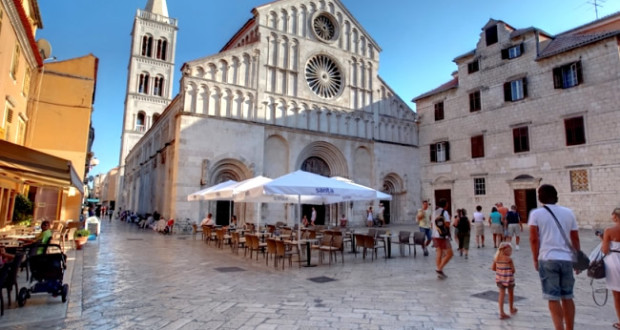The town of Zadar in the country of Croatia is located about 160km from the more famous town of Split and is in the county of Zadarska. In existence since around the 9th century BC, the old town is situated on a peninsula and its straight narrow streets reveal how the town was re-set out by the Romans and the harbor wall with its Venetian Lion’s head is testament to it becoming under Venetia rule in the 16th century. It is the wooded suburbs that lie near the beach 6km northwest of the old town though that have today become a tourist zone.
Most tourist guide books and many tourist guide blog will make mention of Zadar’s many churches which are usually the major point of interest for tourists, along with the many islands that make up the Zadar Archipelago. The churches include the 9th century Byzantine church of St Donat, the 13th century Cathedral of St Anastasia the largest cathedral in Dalmatia, the oldest example of a Gothic church in Dalmatia, the Monastery of St. Francis and although Romanesque architecture can be seen at its most beautiful in all Croatia at the St. Stosija’s Cathedral, which dates back to the 13th century, possibly the best examples of Romanesque architecture can be seen at the St. Grisogono’s Church which dates from the 12th century. The town of Zadar includes some of the couple of hundred islands that make up the Zadar Archipelago in the Adriatic Sea, only 20 of which are permanently inhabited. Although all these islands are renowned for their crystal clear waters, probably the most visited are the National Parks of Telascica Nature Park and Kornati Islands National Park. There are though, many attractions that located in Zadar that are not so regular mentioned and these are the hidden attractions of Zadar that I would like to bring attention to here. 5 of perhaps the best of these hidden Zadar attractions are;
- The Museum of Ancient Glass
Located in the Cosmacendi Palace, built in the 19th century, this more recently opened museum houses some of the best and possibly the greatest collection of ancient glass in much of Europe. In order to maintain the architectural beauty of the entrance to the palace, yet permit access to the disabled, the entrance to the museum is in the northwest, through the park. The museum itself consists of three themes, one for the raw materials, one for the tools and furnaces and another for the techniques used in glass making, with the main exhibition area housing perhaps the largest collections of Roman glassware outside of Italy. The museum also includes a hall with a large LCD projector which shows a documentary on how the ancient glass furnaces were used.
- Archaeological Museum
Founded in 1832, this is one of the oldest museums in this part of Europe and is the 2nd oldest in Croatia. As a state museum, it has responsibilities to the county of Zadarska and so also houses the Education Department, Conservation-Restoration Department and Library Department but the museum itself houses exhibits from the Palaeolithic Period right up to the end of the 15th century. The museum consists of three floors with the ground floor displaying exhibits relating to the 7th to the 12th centuries, which was the period that shaped Croatian culture. The first floor houses exhibits relating to the Roman period of dominance in northern Dalmatia and the second floor concentrates on the Prehistoric period with archaeological exhibits that date back as far as 10,000BC and as recent to the arrival of the Romans to the region.
- Donatus Music Evenings
Although many tourists may be told about the St. Donatus Church and even visit this, perhaps a Zadar’s most cultural monument, many do not perhaps the hidden beauty that lies within it. The church’s architecture produces some of the best acoustics that can be experienced anywhere in the world and so the church is renowned for its sacral ambience. For this reason, many evening concerts take place, varying in style from Renaissance and baroque to medieval concerts, each of which is a rich experience not to be missed.
- Roman Ruins
There are several Roman ruins that remain in Zadar and include the largest Roman Forum on the eastern side of the Adriatic. Although many Roman ruins that remain in Europe are from old Roman fortifications, here there are the remains of two squares containing marble columns and perhaps most impressive of all, a Roman Tower that stands on the east of the town. There are also some remains of one of Rome’s noted aqueducts.
- Zadar Sea Organ
This unique experience allows you to hear what sounds like an organ resounding the moans of some lost souls, yet it is just a sound made by the lapping waves of water as they brush the shoreline. The sounds of the organ are perhaps best experienced at night and the sound they produce would perhaps be perfect accompanying music for an Edgar Allan Poe rectal.
 Living There
Living There



